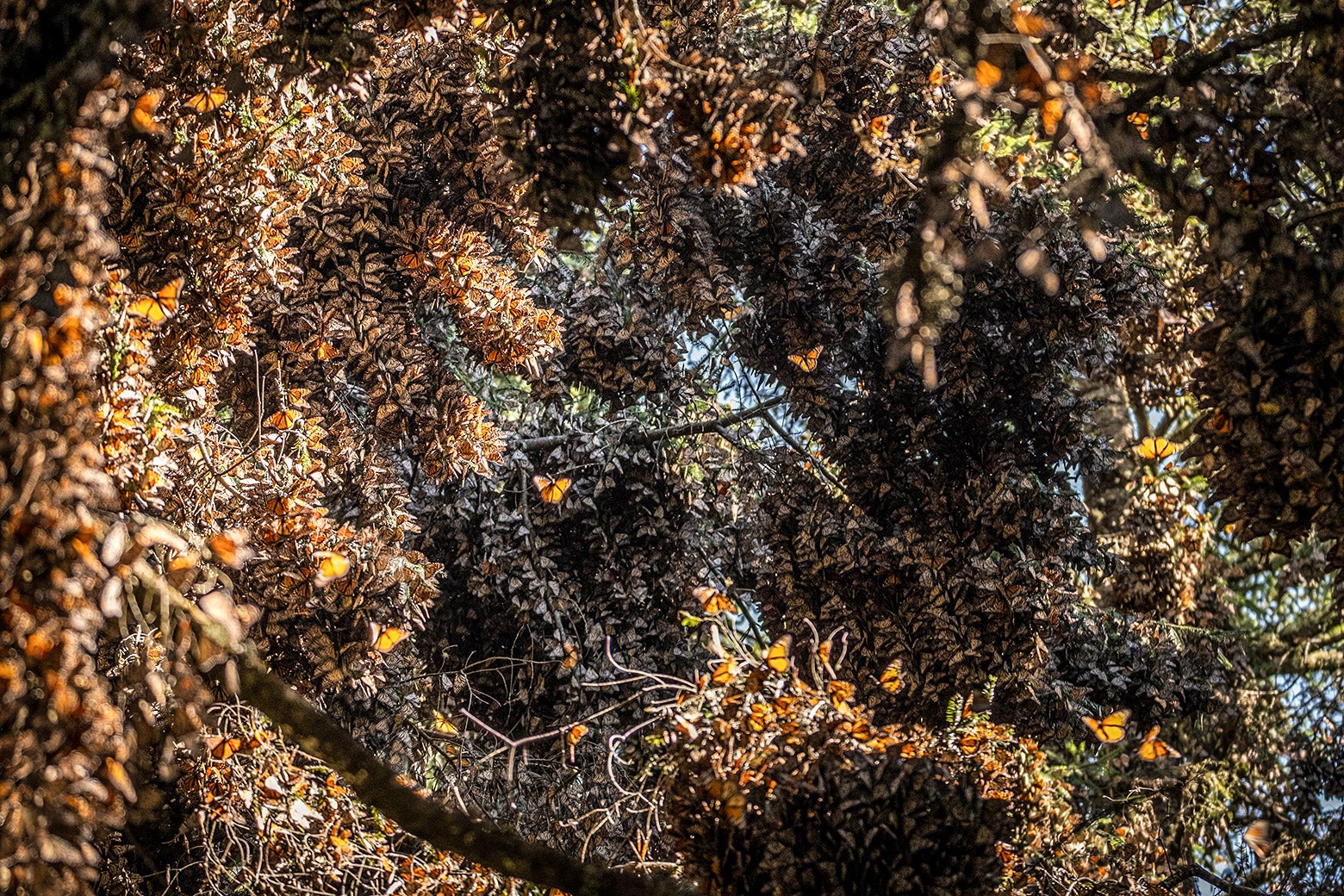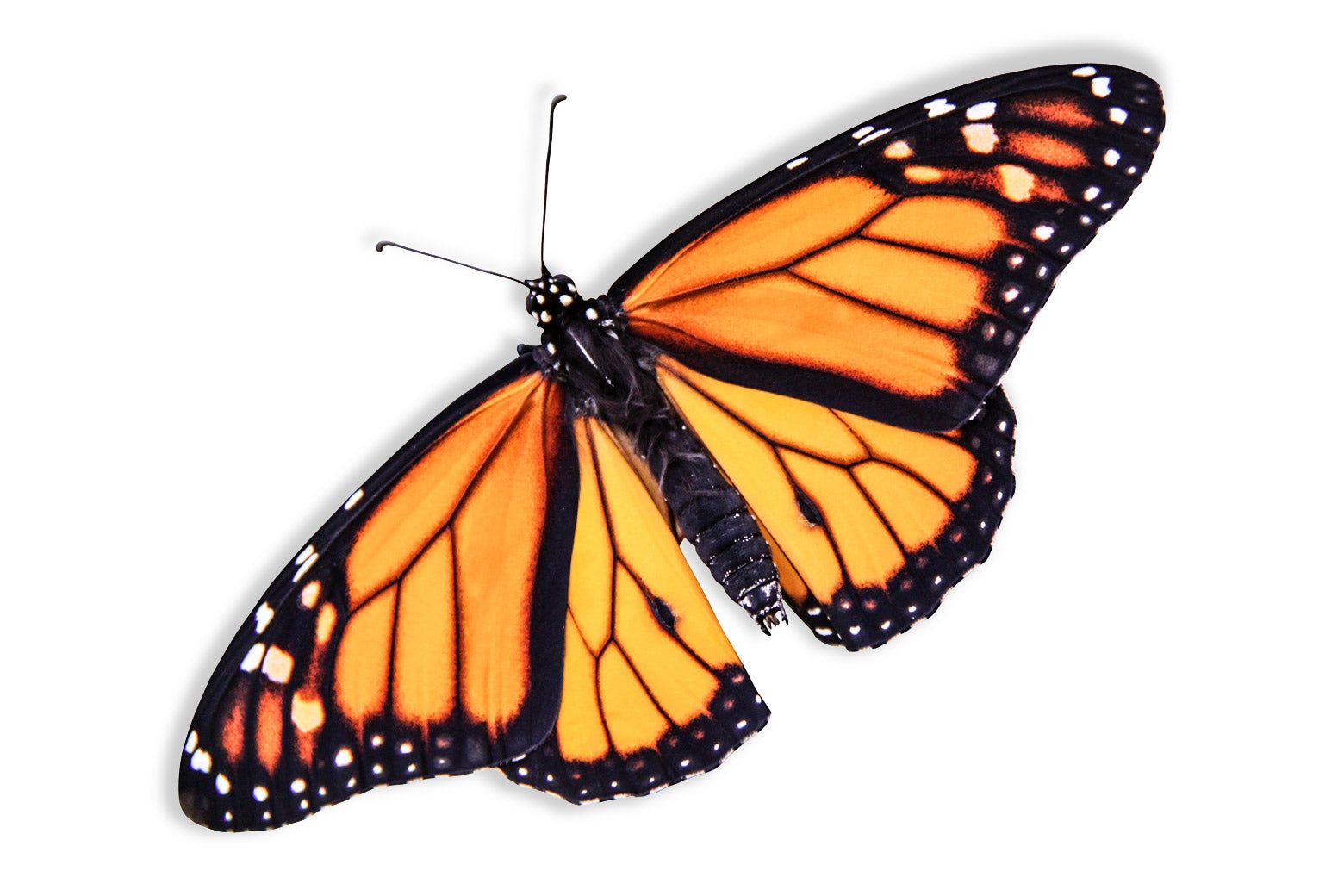MICHOACÁN, Mexico—Hiking high in the mountains of Central Mexico, you could be forgiven for forgetting about the monarch butterflies’ well-publicized problems. Here, millions of butterflies festoon the trees in shuddering layers so thick it’s impossible to see the foliage beneath. Hundreds of thousands more flutter through the thin air into grassy meadows, seeking water and sunshine. It’s December, and they’ve come here to overwinter, migrating up to 2,500 miles, from as far away as Canada; they gather into an area just a few hectares in size. A chorus of soft rustling punctuates it all, an unmistakable and omnipresent thrum—the collective sound of billions of tiny wingbeats.
And yet, problems they have. These populations are declining for reasons that aren’t entirely clear, facing a grab bag of environmental challenges, from climate change and pesticide use, to vehicle traffic and deforestation.
The plight of these monarch butterflies (Danaus plexippus), each no heavier than a sunflower seed, is unusually well-documented. The New York Times alone, for example, covers it roughly monthly, and it’s a been a favorite for publications as diverse as the Associated Press, Fox News, and National Geographic. From lower-back tattoos to your emoji keyboard, there is perhaps no species of insect that has entered our collective consciousness more than the monarch. The orange-and-black critters are a bonified conservation icon.
What might be most surprising about the monarch butterfly, then, is that as a species, it is not actually endangered. The International Union for Conservation of Nature categorizes it a “species of least concern,” the designation reserved for those considered furthest from danger of extinction.
A significant portion of this disconnect can be explained by the amount of press different segments of the global monarch butterfly population receive. Two distinct groups of migratory monarchs exist in North America: the aforementioned Mexican-Canadian population and a smaller population west of the Rockies that overwinters in California. It seems journalists simply can’t resist using these breathtaking, drama-filled migration spectacles for an attention-grabbing headline or lede (guilty!). So, as far as many people are aware, these are the only monarchs that exist—let’s call them the celebrity North American migrators. And it’s true: These populations, in Mexico and California, are on the downswing. The Western population in particular has been raising alarm bells, with some estimates putting the decimation as high as a 99 percent decline over the past few decades.
After years of public pressure, our celebrity North American migratory subpopulations were listed as, yes, an endangered species in July. However, you’d be mistaken to think that monarchs are in dire need of our help—or remotely close to extinction.
There are many, many more populations of monarchs. Danaus plexippus is also native throughout the rest of the Americas, with stable populations found in Florida, through the entirety of Central America and the Caribbean, and as far south as Venezuela. In the 1800s, likely as unintentional stowaways on trade ships, the insect colonized much of the tropical world. Today, the butterflies can also be found in abundance in Spain, Morocco, Hawaii, Australia, New Zealand, Indonesia, and much of the South Pacific; in these locales, they are a largely harmless, non-native, but still immensely successful species. Furthermore, there are two other species of monarch, which are also apparently stable in their numbers—Danaus erippus, which inhabits the southern half of South America, and Danaus cleophile, exclusive to the islands of Jamaica and Hispaniola.
Even when it comes to the North American migratory subpopulations, the science is far from settled on just how urgent their peril is. Like many insect species, monarchs naturally have enormous population fluctuations from year to year. There’s no reliable data prior to 1993 on the North American monarch butterfly headcount. It’s possible that the years when reliable data collection started were anomalously abundant, and populations today have simply settled into more reasonable numbers
“It’s been argued by some that this period of time could have been a ‘blip’ in terms of how high the population was,” says Anurag Agrawal, a professor of ecology and evolutionary biology at Cornell University, and author of Monarchs and Milkweed, though he cautions that this hypothesis certainly isn’t a fact, simply a possibility. “Overwintering populations [in Mexico], which are really important, really have declined in the last 30 years,” Agrawal explains. “However, it is unclear whether they’re threatened.” That is, there’s not a clear culprit to attribute their decline to.
Without knowing the historical populations, or specifically what is driving down the overwintering populations, it’s not possible to be sure just how dire things like climate change, herbicide and pesticide use, or deforestation really are to this group of insects. In fact, the Californian overwintering colonies increased more than a hundredfold between 2020 and 2021 (although, it’s quite possible that bump is just a fluctuation itself).
There’s also something curious happening to these potentially threatened populations when they are residing further North. A paper published in the of Global Change Biology in June assessed population trends during summers, when breeding monarch butterflies proliferate across the United States and southern Canada. Compiling over 135,000 observations from 1993 to 2018, the authors’ conclusion came as a surprise to many: On measure, there is no compelling evidence that the summertime populations of monarchs are experiencing any significant declines.

This is, of course, rather confusing: How can the same group of insects be declining in Mexico but stable when they return north?
The migration takes place annually across four separate generations, so it’s not actually one group of butterflies making the trek. (Three out of the four generations will live for four to six weeks, with the fourth generation—the overwinterers—living for up to nine months.) Each individual female can lay around 400 eggs in her lifetime. Crunching the numbers, this means a single butterfly flying north from Mexico will potentially have millions of descendants within a year. This enormous level of fecundity appears to compensate for any declines experienced over the winter, the Global Change Biology paper explains—a relatively small population can explode quickly. It’s possible that migratory monarchs face issues during the migration south, or at the overwintering sites themselves; thus, the population shrinks in the winter, only to expand again in the summer.
Enormous natural population fluctuations, insufficient long-term data, and conflicting scientific conclusions—there’s just no real consensus right now on what’s really happening with these butterflies. And again, we’re talking just about one segment of monarchs on the planet that is on the downswing. What remains clear, however, is the public’s enthusiasm for the charismatic creature.
Regardless of the complex scientific realities, the monarch has ascended to become a conservation celebrity, a flagship species in the fight to save pollinators. Studies have suggested that the American public would be willing to pay around $5 billion to “save” the species, a number on par with the gray wolf. Dozens of different organizations such as Monarch Watch and Journey North are actively engaged with tens of thousands of people across the continent, educating, tagging, rearing, and collecting data on the species, in what is surely one of the largest collaborations of citizen science on the planet.
The monarch has all the qualities that serve to capture the human imagination: natural wonder, scientific intrigue, and epic character arcs with a beautiful conclusion. Qualities that, perhaps, convinced you to click on this article in the first place. It’s a potent symbol for environmental politics.
In 2014, when President Barack Obama signed a memorandum promoting the conservation of pollinators, he singled out the monarch, along with the honeybee, to illustrate the gravity of the concern. What is or isn’t happening with the monarch populations aside, the prevailing opinion among the scientific community is that the butterflies are a largely ineffective and unimportant pollinator. A 2004 book minced no words, saying, “If monarchs became extinct tomorrow, it is likely that the impact on our material well-being would be negligible.”
The monarch’s undeniable charisma and widespread accessibility make it a compelling ambassador for the world of conservation science. Most of us will only lay eyes on a polar bear in the dreary confines of a zoo, if that. But from Texas to Toronto, people can encounter the monarch in their own backyards. Counterintuitively, it’s their abundance that makes them such an effective conservation symbol, and if you’re reading this from the continental United States, you too can help by encouraging natural wildflowers to grow in your area, or collecting data on behalf of the scientific community. The barrier to engagement is as low as stepping outside.
The hope is, of course, that people won’t just help out with the monarchs; it’s that they’ll become concerned about animals in general, even the ones that don’t get airtime. You’ve probably never heard of the flat pigtoe mussel or the little Mariana fruit bat. They are among the dozens of species declared extinct in 2022, each no less important to their respective ecosystems than the monarch butterfly is to its.
In reality, conservation is “not about any single species,” says Agrawal. Focusing intently on supporting one particular species is “a way to trick ourselves into thinking we’re doing a lot of good,” he explains. “Our goal isn’t to save the monarch. It’s to save our functional ecosystems.”
For those that want to help, Agrawal’s advice probably sounds familiar: “Consume a little less, and provide a little more. I know it sounds small, but small things are contagious.” Furthermore, he encourages people to educate themselves as much as possible and, if able, donate to conservation organizations that they care about.
All this is not to say that the monarch butterfly is not beautiful or worthwhile. It’s just that the species may not be as black-and-white—or rather, black-and-orange—as it’s typically portrayed.
